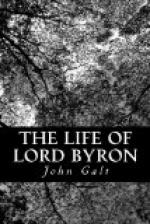It has been already mentioned, that while the poet was at Dr Glennie’s academy at Dulwich, he read an account of a shipwreck, which has been supposed to have furnished some of the most striking incidents in the description of the disastrous voyage in the second canto in Don Juan. I have not seen that work; but whatever Lord Byron may have found in it suitable to his purpose, he has undoubtedly made good use of his grandfather’s adventures. The incident of the spaniel is related by the admiral.
In the licence of Don Juan, the author seems to have considered that his wonted accuracy might be dispensed with.
The description of Haidee applies to an Albanian, not a Greek girl. The splendour of her father’s house is altogether preposterous; and the island has no resemblance to those of the Cyclades. With the exception of Zea, his Lordship, however, did not visit them. Some degree of error and unlike description, runs indeed through the whole of the still life around the portrait of Haidee. The fete which Lambro discovers on his return, is, however, prettily described; and the dance is as perfect as true.
And farther on a group of Grecian girls,
The first and tallest her white kerchief waving,
Were strung together like a row of pearls,
Link’d hand in hand and dancing; each too having
Down her white neck long floating auburn curls.
Their leader sang, and bounded to her song,
With choral step and voice, the virgin throng.
The account of Lambro proceeding to the house is poetically imagined; and, in his character, may be traced a vivid likeness of Ali Pasha, and happy illustrative allusions to the adventures of that chief.
The fourth canto was written at Ravenna; it is so said within itself; and the description of Dante’s sepulchre there may be quoted for its truth, and the sweet modulation of the moral reflection interwoven with it.
I pass each day where Dante’s bones are laid;
A little cupola, more neat than solemn,
Protects his dust; but reverence here is paid
To the bard’s tomb and not the warrior’s
column.
The time must come when both alike decay’d,
The chieftain’s trophy and the poet’s
volume
Will sink where lie the songs and wars of earth,
Before Pelides’ death or Homer’s birth.
The fifth canto was also written in Ravenna. But it is not my intention to analyze this eccentric and meandering poem; a composition which cannot be well estimated by extracts. Without, therefore, dwelling at greater length on its variety and merits. I would only observe that the general accuracy of the poet’s descriptions is verified by that of the scenes in which Juan is placed in England, a point the reader may determine for himself; while the vagueness of the parts derived from books, or sketched from fancy, as contrasted with them, justifies the opinion, that invention was not the most eminent faculty of Byron, either in scenes or in characters. Of the demerits of the poem it is only necessary to remark, that it has been proscribed on account of its immorality; perhaps, however, there was more of prudery than of equity in the decision, at least it is liable to be so considered, so long as reprints are permitted of the older dramatists, with all their unpruned licentiousness.




